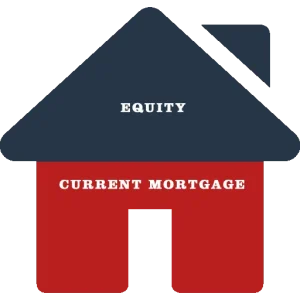Are you a homeowner with equity in your property?
If so, you might be considering ways to access that value, perhaps to fund a home improvement, consolidate debt, or support other financial goals.
One common method is remortgaging, but it’s not the only option, and it might not be the right fit for your situation. You may find yourself wondering, “Can I release equity without remortgaging?“
In this article, you’ll explore the concept of releasing equity, understand why you might seek alternatives to remortgaging, and discover the various options available to you.

Understanding Equity
Equity is the value of your home that you truly own.
It’s the difference between your property’s current market value and the remaining balance on your mortgage. As you pay off your mortgage and as your home’s value potentially increases, your equity grows.
Now, you might be thinking about releasing some of that equity, but what does that mean?
Equity release is a way for you to access the money tied up in your home without having to sell it. It’s like unlocking a financial resource that you can use for various purposes, such as home improvements, second property, or even helping your family.
Remortgaging is a common way to release equity. It involves taking out a new mortgage that’s larger than your existing one, and then using the extra funds for your chosen purpose.
But it’s not the only way, and it might not be the best way for you.
Aren’t equity release mortgages for retired people?
It’s easy to get confused with this concept, as many of the terms are interchanged between mortgage products. The answer to this question is no, not always.
The basic principle is the same across all products, it is a loan that accesses home equity.
A remortgage or secured loan can be used to release equity. But an equity release remortgage could mean the same thing !
In the main, when referring to an equity release mortgage, or equity release plan, it means those plans suitable for people age 55 and over. These access quite modest amounts of equity and don’t require any details concerning your income or expenditure.
Oh, and you don’t need to be retired to take advantage of any of these options!
Why Consider Alternatives to Remortgaging?
Remortgaging to release equity is a well-known option, but it’s not always the best fit for everyone. You might find yourself in a situation where you want to explore other ways to access your home’s value.
Here’s why you might consider alternatives to remortgaging:
Costs
Remortgaging can come with fees and charges, like arrangement fees, early repayment charges and valuation costs. If you’re looking to avoid these expenses, other options might be more appealing.
Time
The process of remortgaging can take time, especially if you’re shopping around for the best deal. If you need access to funds more quickly, you might want to look at faster alternatives.
Flexibility
Remortgaging often means committing to a new long-term mortgage deal. If you want more flexibility or don’t want to change your current mortgage terms, other methods might suit you better.
Eligibility
Your ability to remortgage might be affected by your credit score, income, or other factors. If you’re concerned about qualifying for a new mortgage, exploring other ways to release equity could be a wise move.
Personal Goals and Circumstances
Your reasons for wanting to release equity and your overall financial situation might make one option more suitable than another. Understanding your unique needs and goals will guide you to the right choice.
CONTACT A REMORTGAGE EXPERT
If you wish to investigate your re-mortgage options we can put you in touch with a fully qualified whole of market mortgage broker.
Alternatives to Remortgaging
If remortgaging doesn’t seem like the right fit for you, don’t worry. There are other ways you can release equity from your home.
Let’s explore some of the alternatives that might suit your needs:
Further Advance
A further advance is when you borrow more money from your current mortgage lender, using the equity in your home as security. It’s essentially an additional loan on top of your existing mortgage.
A further advance can be a convenient option, especially if you have a good relationship with your current lender and want to keep your existing mortgage deal. It might be used for home improvements, consolidating debts, or other financial needs.
Second Charge Mortgages
Also known as a secured loan, a second charge mortgage is an additional loan secured against your property, tapping into the equity value. But this one will be provided by a new lender.
It sits alongside your main mortgage (which remains untouched), and you’ll make separate repayments. It might be an option if you have a great deal on your current mortgage that you don’t want to lose.
Bridging Loans
Bridging loans are very much misunderstood and many of you will never need one.
But they are a useful option to know about.
Basically a bridging loan is a short term loan that is secured against a property (with or without a main mortgage in place). They access your equity and can be arranged very quickly. Importantly they do not affect your main mortgage.
Pros and Cons
Some quick pros and cons for the alternative options.
Remortgaging
Remortgaging involves switching your current mortgage to a new deal, with a new lender. It can provide potential savings through lower interest rates and allows for additional borrowing.
Pros: Potential for lower interest rates; opportunity to consolidate mortgage and additional borrowing.
Cons: Will incur fees; could extend mortgage term; risk of losing current mortgage deal and ERCs.
Further Advance
A further advance involves borrowing more money from your current mortgage lender, using the equity in your home.
Pros: Convenient option with current lender; may align with existing mortgage terms; suitable for various financial needs.
Cons: Eligibility; You may no longer meet the lenders eligibility criteria or they do not accept the reason for the additional borrowing.
Second Charge Mortgages
A second charge mortgage is a loan secured against your property, in addition to your primary mortgage.
Pros: Allows you to keep your current mortgage deal; can be used for various purposes, including home renovations, debt consolidation or property investment.
Cons: Generally comes with higher interest rates; additional loan to manage; potential for more complex repayment structure.
Bridging Loans
Bridging finance is used regularly by businesses and property investors, but they are available to anyone with a property.
Pros: Quick to arrange, don’t ask too many questions and the loans are only temporary, typically 3-24 months.
Cons: Arrangement fees and higher interest rates. You will need to pay the loan off in full by the end date.
How much can you borrow?
When borrowing money against your own home, all lenders will need to carry out credit checks and affordability checks. This is because the mortgage could affect your home if you fall behind with the repayments.
The amount you can borrow will be affected by the available equity and your own financial situation.
The maximum loan to value LTV when releasing equity will be in the range of 75-90% of your property value.
This percentage includes any existing mortgage balances.
All lenders will be checking your credit report and credit history. Any bad credit won’t necessarily stop you from borrowing more money but it is likely to reduce the number of lenders you can approach.
LTV Calculator
This simple calculator will quickly work out your loan to value (LTV) percentage. Just enter the property value, or purchase price, and the mortgage amount you need.
Get access to expert brokers and specialist second charge lenders
Award winning service
Independent mortgage advice
FCA Regulated
Which is the best option?
The thing about mortgages and loans is there is no 'one size fits all' solution.
We are all different, and have different levels of income, debt and equity.
Using a remortgage to generate extra cash is normally regarded as the most sensible option, as you tend to get access to the most competitive rates.
Where that is not possible, approaching your current lender for a further advance is a good alternative.
If your existing lender can't help then a second charge mortgage gives you access to cash. The lenders are pretty flexible but you will be charged more interest than the previous options.
Where there is a need for urgent cash, a bridging loan is the best option. You can get your money in around two weeks, but the rates will be high.
You will find more useful information in our guide to Borrowing for home improvements
Remortgaging at a later date
It's likely that you would prefer to avoid remortgaging for two reasons:
- You have a great interest rate and don't want to lose it
- You will need to pay very high ERCs by switching lenders
These are both valid reasons and the consequences of either could run into thousands of pounds.
But it is still important to look ahead, and plan for when you can remortgage.
Make a note of when your fixed rate ends or when the early repayment charges stop
This is likely to be the time when you can cost effectively remortgage with a new lender.
Check the date for when the interest rate finishes and when the fees end.
Sometimes the dates are different!
Start looking at remortgage options around 3 months before
A remortgage will generally take around 4-8 weeks from when you apply.
But you also need to factor in the time searching for the right deal. Contact your broker as early as possible, so they can check all the calculations and get to work.
Don't worry about it starting too soon. Your broker will handle this.
Remortgage to a new deal and consolidate the more expensive borrowing
Applying for a new mortgage will give you the opportunity to bring the extra borrowing within your main mortgage.
This will enable all of the mortgage debt to be under one interest rate, with one monthly repayment.
Before going ahead, it's also important to double check for any exit fees for the further advance, secured loan that you took out.

Bridging Loans Guide
In this guide, we will provide an overview of bridging loans and offer some tips on how to get the best deal for short term finance.

Remortgage Guide
Our Guide covers the remortgage process, including how long it takes, and the different options you have when switching your mortgage.

Second Charge Mortgages
In this guide you’ll find everything you need to know about second charge mortgages: what they are, how they work and who could benefit.
Ready to explore your options?
If you're on the cusp of starting your mortgage journey and could use the guiding hand of a professional, don't hesitate to reach out to a reputable mortgage broker.
They will make the process smoother and more profitable than going it alone. And remember, knowledge is power.
The more you know, the better decisions you can make. Keep reading, keep asking questions, and keep moving forward on your journey.


